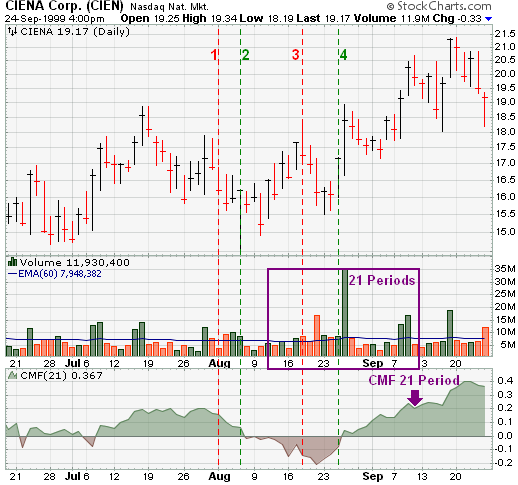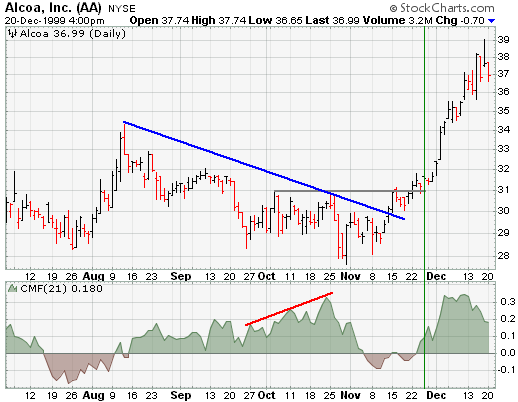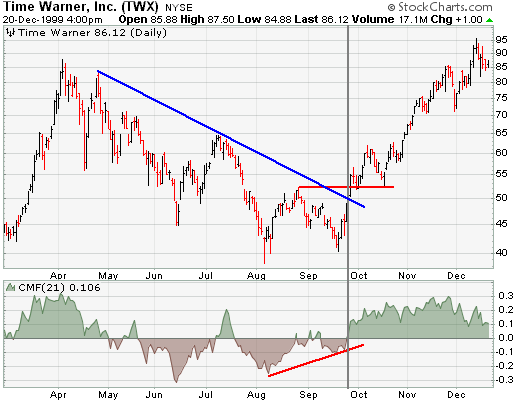
(Click here to see a live example of CMF)
|
Chaikin Money Flow Part 1 Part 1 | Part 2 |
| Introduction |
Developed by Marc Chaikin, the Chaikin Money Flow oscillator is calculated from the daily readings of the Accumulation/Distribution Line. The basic premise behind the Accumulation Distribution Line is that the degree of buying or selling pressure can be determined by the location of the close relative to the high and low for the corresponding period (Closing Location Value). There is buying pressure when a stock closes in the upper half of a period's range and there is selling pressure when a stock closes in the lower half of the period's trading range. The Closing Location Value multiplied by volume forms the Accumulation/Distribution Value for each period. (See our Chart School article for a detailed analysis of the Accumulation/Distribution Line.)
Ciena

(Click
here to see a live example of CMF)
| Methodology |
The CIEN chart details the breakdown of the daily Accumulation/Distribution Values and how they relate to Chaikin Money Flow. The formula for Chaikin Money Flow is the cumulative total of the Accumulation/Distribution Values for 21 periods divided by the cumulative total of volume for 21 periods.
On the CIEN chart, the purple box encloses 21 days of Accumulation/Distribution Values. The total of these 21 days divided by the total for the 21 days of volume forms the value of Chaikin Money Flow at the end of that day (purple arrow). To calculate the next day, the Accumulation/Distribution Value from the first day is removed and the value for the next day is entered into the equation.
The number of periods can be changed to best suit a particular security and timeframe. The 21-day Chaikin Money Flow is a good representation of the buying and selling pressure for the past month. A month is long enough to filter out the random noise. By using a longer timeframe, the indicator will be less volatile and be less prone to whipsaws. For weekly and monthly charts, a shorter timeframe is usually suitable.
Generally speaking, Chaikin Money Flow is considered bullish when it is positive and bearish when it is negative. The next item to assess is the length of time Chaikin Money Flow has remained positive or negative. Even though divergences are not an intricate part of the strategy behind Chaikin Money Flow, the absolute level and general direction of the oscillator can be important.
| Accumulation Indications |
The Chaikin Money Flow oscillator generates bullish signals by indicating that a security is under accumulation. There are three items that determine if a security is under accumulation and the strength of the accumulation.
Alcoa

On the chart for AA, Chaikin Money Flow actually strengthened while the stock continued to decline. For most of October, the stock traded flat while Chaikin Money Flow remained positive and continued to strengthen. The accumulation levels, as evidenced by Chaikin Money Flow, were very strong in October. The stock fell at the end of October and Chaikin Money Flow declined in November. When the stock fell, distribution levels never surpassed -.10, indicating that selling pressure was not that intense. In late November, the stock managed a comeback and broke resistance at 31. Chaikin Money Flow formed a higher low and returned to positive territory to confirm the breakout. Selling pressure dried up quickly and Chaikin Money Flow was able to bounce back in strong fashion. The evidence is clearly bullish, but to capitalize a trader would have had to act fast.
Time Warner

The chart for Time Warner is a bit different. The stock formed a double bottom in August and September while Chaikin Money Flow formed a rather large positive divergence. This divergence was not a signal, but would have served as an alert that the selling pressure was decreasing. Divergences can be difficult to act on and should be used in conjunction with other aspects of technical analysis. By the time the stock broke resistance at 52, Chaikin Money Flow has moved from a mildly bearish levels just above -.10 to moderately bullish levels just above +.13. The interesting point about Time Warner is the period from 28-Sept to 22-Oct (gray lines). During this period, the stock traded sideways, but Chaikin Money Flow continued to strengthen as buying pressure intensified. The oscillator moved from +.1208 on 28-Sept to +.2377 on 22-Oct. Buying pressure has nearly doubled. This was a clearly bullish indication and the stock soon obliged with an advance from the low fifties to over 90.
In Part 2, we examine how Chaikin Money Flow measures distribution or selling pressure and offer some strategies for using the oscillator with other indicators.
Part 1 | Part 2